R848 Is Involved in the Antibacterial Immune Response of Golden Pompano (Trachinotus ovatus) Through TLR7/8-MyD88-NF-κB-Signaling Pathway
- PMID: 33537035
- PMCID: PMC7848160
- DOI: 10.3389/fimmu.2020.617522
R848 Is Involved in the Antibacterial Immune Response of Golden Pompano (Trachinotus ovatus) Through TLR7/8-MyD88-NF-κB-Signaling Pathway
Abstract
R848 is an imidazoquinoline compound that is a specific activator of toll-like receptor (TLR) 7/8 and is often used in immunological research in mammals and teleosts. However, the immune responses initiated by R848 through the TLR7/8 pathway in response to bacterial infection remain largely unexplored in teleosts. In the current study, we investigated the antibacterial response and the participating signaling pathway initiated by R848 in golden pompano (Trachinotus ovatus). We found that R848 could stimulate the proliferation of head kidney lymphocytes (HKLs) in a dose-dependent manner, enhance the survival rate of HKLs, and inhibit the replication of bacteria in vivo. However, these effects induced by R848 were significantly reduced when chloroquine (CQ) was used to blocked endosomal acidification. Additionally, an in vivo study showed that R848 strengthened the antibacterial immunity of fish through a TLR7/8 and Myd88-dependent signaling pathway. A cellular experiment showed that Pepinh-MYD (a Myd88 inhibitor) significantly reduced the R848-mediated proliferation and survival of HKLs. Luciferase activity analysis showed that R848 enhanced the nuclear factor kappa B (NF-κB) activity, whereas this activity was reduced when CQ and Pepinh-MYD were present. Additionally, when an NF-κB inhibitor was present, the R848-mediated pro-proliferative and pro-survival effects on HKLs were significantly diminished. An in vivo study showed that knockdown of TLR7, TLR8, and Myd88 expression in golden pompano via siRNA following injection of R848 resulted in increased bacterial dissemination and colonization in fish tissues compared to that of fish injection of R848 alone, suggesting that R848-induced antibacterial immunity was significantly reduced. In conclusion, these results indicate that R848 plays an essential role in the antibacterial immunity of golden pompano via the TLR7/8-Myd88-NF-κB- signaling pathway.
Keywords: Myd88; NF-κB; R848; TLR7/8; antibacterial immune response.
Copyright © 2021 Zhou, Chen, Cao, Li, Long, Wu, Zhang and Sun.
Conflict of interest statement
The authors declare that the research was conducted in the absence of any commercial or financial relationships that could be construed as a potential conflict of interest.
Figures
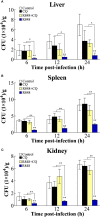
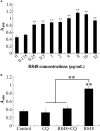
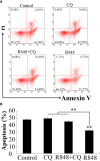
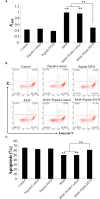
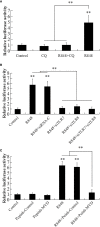
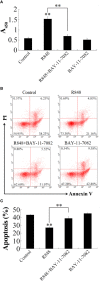
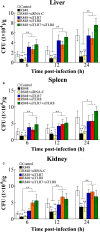
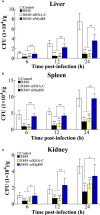

Similar articles
-
Immune effects of R848: evidences that suggest an essential role of TLR7/8-induced, Myd88- and NF-κB-dependent signaling in the antiviral immunity of Japanese flounder (Paralichthys olivaceus).Dev Comp Immunol. 2015 Mar;49(1):113-20. doi: 10.1016/j.dci.2014.11.018. Epub 2014 Dec 1. Dev Comp Immunol. 2015. PMID: 25475963
-
Insulin-like growth factor binding protein 5b of Trachinotus ovatus and its heparin-binding motif play a critical role in host antibacterial immune responses via NF-κB pathway.Front Immunol. 2023 Feb 14;14:1126843. doi: 10.3389/fimmu.2023.1126843. eCollection 2023. Front Immunol. 2023. PMID: 36865533 Free PMC article.
-
CpG ODN 2102 promotes antibacterial immune responses and enhances vaccine-induced protection in golden pompano (Trachinotusovatus).Fish Shellfish Immunol. 2023 Jun;137:108783. doi: 10.1016/j.fsi.2023.108783. Epub 2023 May 1. Fish Shellfish Immunol. 2023. PMID: 37137380
-
Effects of dietary leucine levels on intestinal antioxidant status and immune response for juvenile golden pompano (Trachinotus ovatus) involved in Nrf2 and NF-κB signaling pathway.Fish Shellfish Immunol. 2020 Dec;107(Pt A):336-345. doi: 10.1016/j.fsi.2020.10.012. Epub 2020 Oct 17. Fish Shellfish Immunol. 2020. PMID: 33080319
-
Molecular cloning and expression analysis of toll-like receptor genes (TLR7, TLR8 and TLR9) of golden pompano (Trachinotus ovatus).Fish Shellfish Immunol. 2017 Apr;63:270-276. doi: 10.1016/j.fsi.2017.02.026. Epub 2017 Feb 20. Fish Shellfish Immunol. 2017. PMID: 28232281
Cited by
-
Polarization of tumor-associated macrophages by TLR7/8 conjugated radiosensitive peptide hydrogel for overcoming tumor radioresistance.Bioact Mater. 2022 Jan 3;16:359-371. doi: 10.1016/j.bioactmat.2021.12.033. eCollection 2022 Oct. Bioact Mater. 2022. PMID: 35386314 Free PMC article.
-
Anti-Tumor Efficacy of a Mesothelin-Based Nanovaccine in a KPC Orthotopic Mouse Model of Pancreatic Cancer.Vaccines (Basel). 2025 Mar 14;13(3):314. doi: 10.3390/vaccines13030314. Vaccines (Basel). 2025. PMID: 40266223 Free PMC article.
-
TLR7 in channel catfish (Ictalurus punctatus) is expressed in the endolysosome and is stimulated by synthetic ssRNA analogs, imiquimod, and resiquimod.Dev Comp Immunol. 2024 Aug;157:105197. doi: 10.1016/j.dci.2024.105197. Epub 2024 May 17. Dev Comp Immunol. 2024. PMID: 38763479 Free PMC article.
-
Rapid Natural Killer Cell Gene Responses, Generated by TLR Ligand-Induced Trained Immunity, Provide Protection to Bacterial Infection in rag1-/- Mutant Zebrafish (Danio rerio).Int J Mol Sci. 2025 Jan 23;26(3):962. doi: 10.3390/ijms26030962. Int J Mol Sci. 2025. PMID: 39940731 Free PMC article.
-
Immune Cells Release MicroRNA-155 Enriched Extracellular Vesicles That Promote HIV-1 Infection.Cells. 2023 Jan 31;12(3):466. doi: 10.3390/cells12030466. Cells. 2023. PMID: 36766808 Free PMC article.
References
Publication types
MeSH terms
Substances
LinkOut - more resources
Full Text Sources
Other Literature Sources
Miscellaneous

